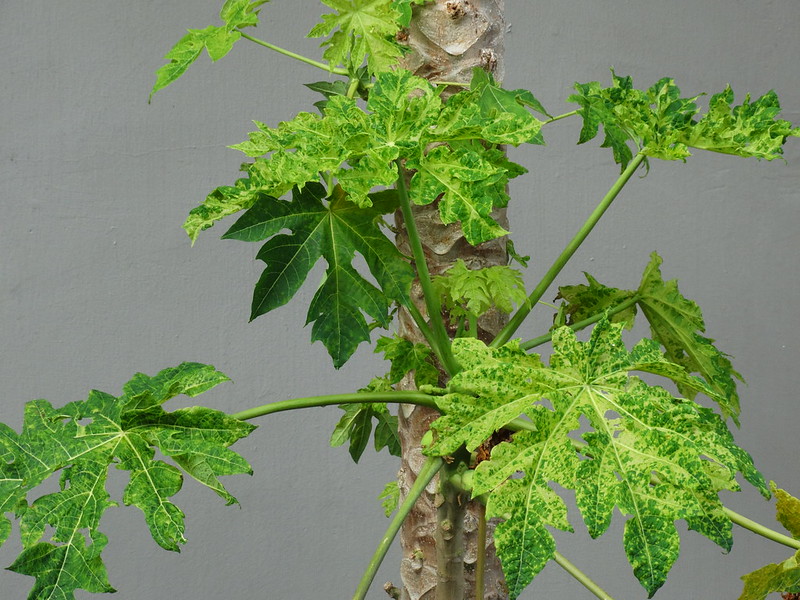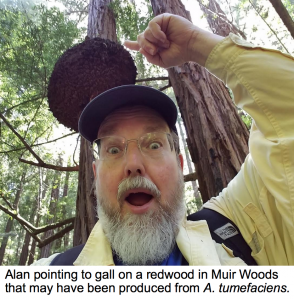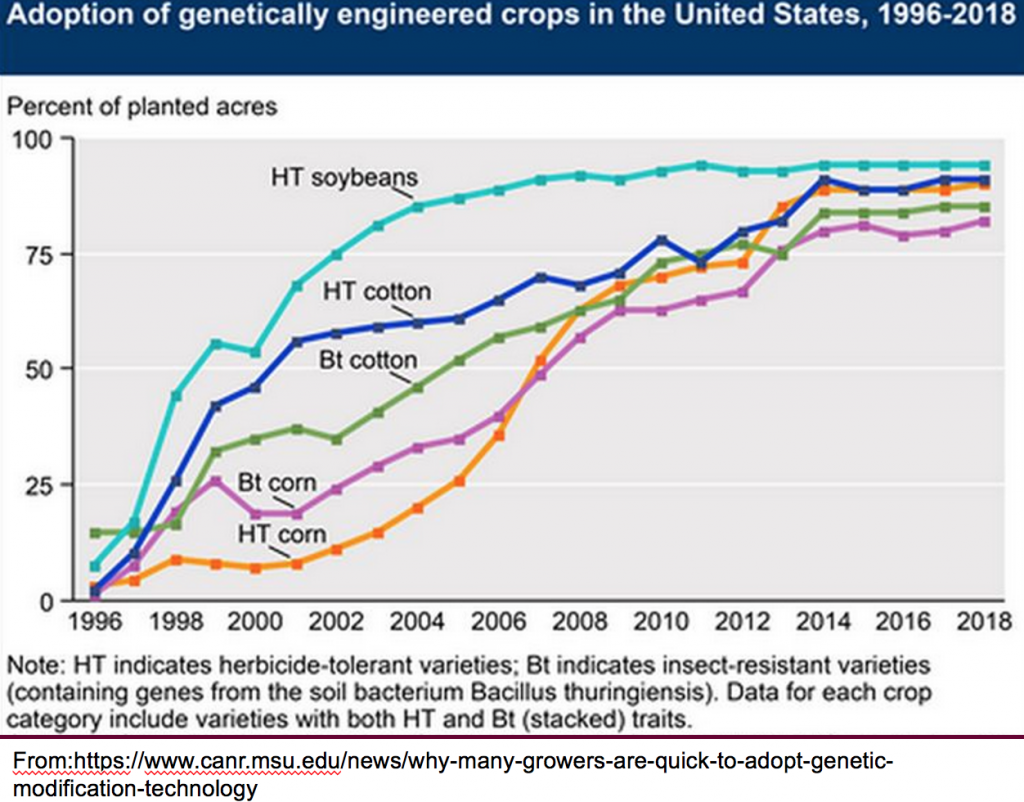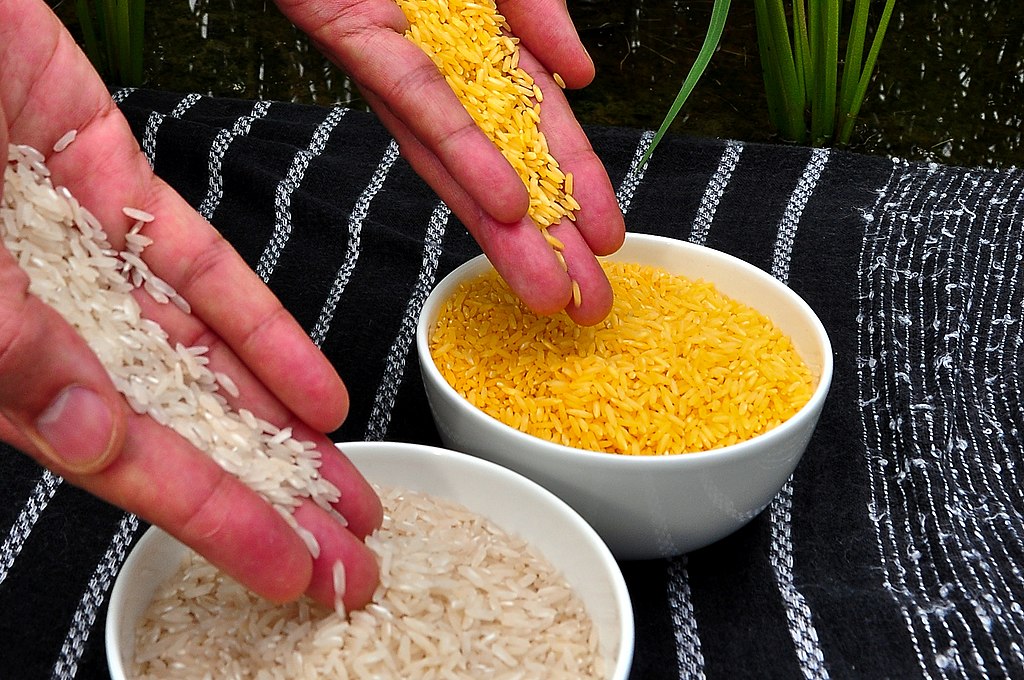15.2 GMOs
Learning objectives
By the end of this lesson you will:
- Understand why and how GMO technology is applied to plant improvement.
- List examples of GMO crops and explain why they were adopted.
- Explain why GMO technology is controversial.
Overview
A GMO is a genetically modified organism — a plant carrying one or more transgenes as part of its genome. GMOs are produced through genetic engineering, where a transgene from any organism is manipulated to produce a trait in a plant after it has been introduced. Transgenes are DNA that are manipulated to function in a plant to produce a specific trait. They can originate from any other organism, and the new DNA need not be introduced through sexual reproduction as in making crosses for plant breeding. (In non-GMO crops, all genes originate from sexual reproduction.) As discussed in the chapter on DNA, the genetic code is the sequence of bases along a strand of DNA, and is universal among all living organisms, enabling the transfer of a gene from a bacteria, virus, or any organism to a plant. )A transfer of DNA across kingdoms would never occur by sexual reproduction, because interkingdom crosses cannot be made.) GMO technology offers, for example, the possibility of engineering resistance to the corn rootworm by introducing a bacterial transgene into corn or the ability to test a gene from any source in a plant.
This lesson offers insight into how GMOs offer a novel mechanism for plant improvement that can add significant traits to forestry, agronomy, and horticulture crops. Their contributions include herbicide tolerance for improved weed control, resistance to insect and viral pests, and improved health benefits for crops.
Unlike rose and apple breeding, in which hobbyists can breed new crops in their gardens, GMO technology integrates knowledge from genetics, molecular biology, and tissue culture to produce a new GMO crop. These skills would be difficult to combine in the garden, but the plants that are produced are propagated identically to their conventional counterparts. It would be difficult to distinguish the GMO “Innate” potato from a non-GMO potato, unless they were tested for browning, acrylamide production, or disease resistance. GMO potatoes look and behave like other potatoes. Adoption of GMO technology by a farmer requires no new equipment or cultivation techniques.
What is a GMO?

GMOs begin where plant breeding ends. An excellent example of GMO technology occurred after the introduction of Papaya Ringspot Virus (PRSV) to Hawaii. PRSV devastated papaya production to the where point growers could not produce a crop. Attempts to use plant breeding to produce a virus-resistant plant were unsuccessful. No sexually compatible plant with resistance to PRSV could be located, so no amount of traditional plant breeding by crossing would produce resistance. This viral disease prevented papaya production in Hawaii until Dennis Gonsalves, of the US Department of Agriculture, adopted a GMO strategy that had previously been used to produce potatoes resistant to several viruses, and made papayas resistant to PRSV. Today, any papaya produced in Hawaii is likely to be either “SunUp” or “Rainbow,” the GMO cultivars. Although the virus-resistant papaya seems like a win for growers and consumers, it is very controversial. In the 1980s, the early development of GMO technology was tied to large agricultural companies that patented and used the technology in corn, soybeans, and cotton. Others see the “unnatural” movement of a gene from a bacteria to a plant as a process that we should not use.
The GMO papaya is a good example for presenting the process involved in producing a GMO. A first step in developing GMO papaya was to understand the virus, its genome, and its replication. Virologists, those devoting their lives to the study of virus biology, knew that the virus’ genome had a gene encoding a coat protein that surrounded the virus’ genetic material and that was essential to its infection of plant cells. The GMO strategy added a copy of the viral coat protein gene into the plant’s chromosomes. The coat protein protects the virus as it is transmitted from plant to plant, and is essential for replication. The viral gene is engineered to be in the opposite orientation from its orientation in the virus. This opposite orientation of the viral gene, now acting as plant gene, effectively shuts down viral replication before it can cause disease, making the plant resistant.
 |
 |
To introduce the engineered viral gene into the plant’s chromosome without crossing, horticulturist John Sanford invented a means of introducing genes into plant cells by literally shooting the gene into the nucleus of a cell. (John graduated in 1976 from the University of Minnesota with a BS in horticulture, and continued in horticulture to become a professor and researcher at Cornell University.) In this process, DNA of the gene of interest is coated onto particles much smaller than the plant cell’s nucleus. The gun works off of compressed air, similar to a BB gun. The particle coated with the DNA (gene of interest), now in the nucleus, diffuses away from the particle and integrates into the plant’s chromosome. The gene is then expressed and is hertible in the same qualitative manner as other single gene traits. The process of introducing a transgene into a plant is called transformation. The plant cell or the whole plant carrying the engineered gene is said to be transformed or transgenic (synonyms for GMO).
 Could this process ever happen in nature? Agrobacterium tumefaciens is a bacterial plant pathogen that produces crown gall disease. This bacterium transfers a small amount of its DNA (several genes) to the plant as part of its pathogen attack. The photo to the left shows a large gall on a redwood that may have been caused by Agrobacterium. The pathogen’s genes have been engineered through evolution to take over the plant cell’s normal regulation and produce a gall — a callus of rapidly dividing undifferentiated cells similar to a callus. The introduced bacterial genes, now functioning in the gall or callus, produce compounds that feed the Agrobacterium, which produces more pathogenic cells to infect other plants. This is crown gall disease of plants. Biologists studying Agrobacterium’s life cycle realized they could use the natural DNA transfer process to introduce genes into plants by piggy-backing a gene of interest from any organism onto the Agrobacterium’s transfer process. This has been very successful, and is the most used method of gene introduction into many crops. Although the genes to produce a GMO virus-resistant papaya were introduced with the gene gun, most of those in GMO crops were introduced using Agrobacterium.
Could this process ever happen in nature? Agrobacterium tumefaciens is a bacterial plant pathogen that produces crown gall disease. This bacterium transfers a small amount of its DNA (several genes) to the plant as part of its pathogen attack. The photo to the left shows a large gall on a redwood that may have been caused by Agrobacterium. The pathogen’s genes have been engineered through evolution to take over the plant cell’s normal regulation and produce a gall — a callus of rapidly dividing undifferentiated cells similar to a callus. The introduced bacterial genes, now functioning in the gall or callus, produce compounds that feed the Agrobacterium, which produces more pathogenic cells to infect other plants. This is crown gall disease of plants. Biologists studying Agrobacterium’s life cycle realized they could use the natural DNA transfer process to introduce genes into plants by piggy-backing a gene of interest from any organism onto the Agrobacterium’s transfer process. This has been very successful, and is the most used method of gene introduction into many crops. Although the genes to produce a GMO virus-resistant papaya were introduced with the gene gun, most of those in GMO crops were introduced using Agrobacterium.

The gene gun (above) and Agrobacterium-mediated gene introductions are inefficient processes that introduce the gene into only a very small number of plant cells. Since only a single cell receives the gene, plant tissue culture is used to regenerate an entire plant from that single cell. Plant tissue culture uses synthetic growth media to provide the environment for mitotic cell divisions and organization of those cells into shoot and root meristems. When the meristems are formed, the tiny plants can be removed from tissue culture and transferred to soil. This is possible because plant cells are totipotent — they can regenerate a whole plant from a single cell. (Think about about adventitious rooting, where parenchyma cells can divide and differentiate into a root meristem when buried in potting mix.) This capability has been identified in only a few plant species using very specific components in the tissue culture medium to coax the cells to divide and regenerate a whole plant.
As in plant breeding, GMO plants must be assessed and selected for the traits of interest. Introducing a single gene into a plant can produce a large phenotypic change — as in the naturally occuring Shrunken-2 allele that transforms field corn to sweet corn, or the introduction of the Papaya Ringspot Virus coat protein gene to provide virus resistance. Introducing a new gene using GMO technology does not, however, change other genes or traits of the plant’s genome. Being able to maintain all of a cultivar’s characteristics and add a gene for resistance from any organism is a major advantage of GMO technology.
The art of GMO technology is discovering how non-plant organisms (virus, bacteria, fungi, insects, and so on) might contribute a gene to improve a plant, be it through weed control, increased nutrition in foods, or resistance to pests or viruses. GMO crops are produced by interdisciplinary teams with members expert in gene identification, gene engineering, plant breeding, gene introduction, and tissue culture. These skills mimic the steps required for GMO technology: identifying a gene or genes and their source to solve a problem, engineering the gene for plant expression, using the gene gun or A. tumefaciens to introduce into the crop of interest, and assessing the new plant. It is possible that the predicted gene action may not occur and that other genes or gene modifications are necessary. All genes used in crop production today have been through several iterations that improved the outcome after introduction. When a plant has the introduced gene integrated into its chromosomes, it can be crossed with other plants to move the new gene and its traits into other varieties.
Review questions
- What is a GMO?
- What are the two significant advantages of GMO technologies over traditional plant breeding?
- What are the differences between the two processes used to introduce a novel gene into a plant?
- Can a GMO seed, seedling, or mature plant be distinguished from a non-GMO one just by looking at it? What distinguishes the two, either visibly or genetically?
- Where do transgenes come from and how are they introduced into a GMO crop?
Why do farmers pay extra for GMO seeds?
GMO technology has been rapidly adopted by farmers in the US and worldwide (the graph below shows adoption rates for the US in 1996–2018). In the US, corn, soybean, and sugar beet crops are GMO for herbicide tolerance (which allows for improved weed control), insect-resistant GMO cotton is extensively adopted to prevent boll weevil damage. For a more comprehensive list of crops and GMO traits, see the GM Approval Database from the ISAAA.
 As it implies, the “approval” in the name of this database indicates that GMO crops must go through extensive testing and a review process before being allowed into production and into our food stream. The rapid adoption of GMO technology triggered questions of risks that resulted in a review process for all GMO crops by the US Department of Agriculture, the Food and Drug Administration, and the Environmental Protection Agency. The overwhelming scientific evidence indicates GMO crops are safe for the environment and for humans. To read more (optional) on the safety of GMO technology, see the Academics Review’s site on Genetic Roulette for science-based information and critical review of GMO technology risks.
As it implies, the “approval” in the name of this database indicates that GMO crops must go through extensive testing and a review process before being allowed into production and into our food stream. The rapid adoption of GMO technology triggered questions of risks that resulted in a review process for all GMO crops by the US Department of Agriculture, the Food and Drug Administration, and the Environmental Protection Agency. The overwhelming scientific evidence indicates GMO crops are safe for the environment and for humans. To read more (optional) on the safety of GMO technology, see the Academics Review’s site on Genetic Roulette for science-based information and critical review of GMO technology risks.
GMO crops have economic, environmental, and convenience advantages for farmers. Several economic analyses have shown that increased yields from GMO crops are a major impetus for adoption by farmers, even though GMO seeds cost more than conventional seeds. A good example is the rapid adoption of GMO sugar beets that were modified for resistance to the non-selective herbicide Roundup. This allowed the beets to be sprayed with Roundup, killing weeds in the field and leaving the beets unharmed. A 2008 survey of GMO sugar beet growers showed the highest weed control ratings in the history of the survey and the near elimination of mechanical and manual weeding. Weed control had previously been inefficient, requiring herbicide and mechanical controls. Making beets herbicide tolerant increased yield and made weed control convenient. Adoption was greater than 90% one year after the GMO herbicide tolerant seed was made available.
The most significant environmental benefits of GMO technology come from GMO insect resistance. Most insecticides are non-specific, killing beneficial insects as well as the pest, and are toxic to humans, birds, fish, and other organisms. The basis of GMO resistance is the introduction of the Bacillus thuringiensis gene, Bt, into the plant, so the plant produces Bt. You may have heard of Bt as an insect control used in organic food production or mosquito control. Bt has a very low environmental impact because it is highly specific for the target insect, unlike conventional insecticides that can have wide ranging collateral damage when applied. Bt is also very labile, breaking down rapidly in the soil. The Bt gene from B. thuringiensis has been introduced into several crops. Currently, Bt crops include corn (field and sweet), cotton, potato, eggplant, tobacco, and soybean for control of several insect pests. Each crop has a specific Bt that targets the insect pest in that crop. Where the GMO crop is grown in place of conventional crops, insecticide applications have been greatly reduced. The battle continues, however, as insects develop resistance to Bt, leaving the crop susceptible to insect damage.
Although using GMO technology requires a significant investment to develop a crop, propagation and use by a farmer is identical to that of conventional counterparts. The simplicity and effectiveness of GMO crops has accelerated their adoption by farmers. GMO herbicide tolerance, for example, allows for a single post-germination application that provides improved weed control, eliminating the need to apply several different herbicides at different times and to use mechanical weed removal. This single application reduces fuel cost for farmers, reduces carbon emission, and provides excellent weed control. It is called herbicide tolerance because genes are introduced into the crop to make it tolerant (resistant) to a specific herbicide that kills weeds. The convenience to the farmer comes from using a single herbicide with flexible timing of application to the crop.
Review questions
- What advantages does a GMO crop present to a farmer?
- Do any of the advantages of a GMO crop for a farmer translate to advantages to the consumer?
- Why were GMO crops adopted so rapidly by farmers?
- What are two examples of GMO crops that were rapidly adopted?
- What does a farmer need to do to adopt a GMO crop with insect resistance?
GMO crops benefiting human health
Early in the technology’s development, most GMO work focused on the farmer and/or on production problems. Herbicide tolerance, insecticide resistance, and virus resistance each protected the crop or made farming easier. There are now, however, several GMO crops developed primarily for the consumer. The iconic, increased-nutrition GMO crop is Golden Rice. It contains introduced genes that synthesize carotene in the endosperm. You can easily distinguish Golden Rice from conventional rice by its yellow color from the accumulated carotene, the same pigment found in carrots (see photo below). When humans consume the carotene in Golden Rice, it is converted to vitamin A, an essential vitamin for human health. Conventional milled-rice contains no vitamin A, which results in vitamin A deficiencies in millions of adults and children who consume most of their calories by eating rice. The Golden Rice Project estimates the number of child deaths caused by vitamin A deficiency at 1.15 million/year. Vitamin A deficiency also causes loss of sight, increased susceptibility to a number of diseases, and reduced intellectual development. While Golden Rice would greatly mitigate the problem and has been crossed into many regional cultivars, adoption has been slowed or blocked by anti-GMO organizations. Research continues with the development of golden bananas and cassava.

A recently approved GMO crop for production, the “Innate” potato has introduced genes that reduce the production of the neurotoxin acrylamide. Acrylamide forms in many cooked foods from the reaction of amino acids, sugars, and heat. The risk of consuming acrylamide is somewhat controversial, but the fact that it is a neurotoxin makes this an important improvement to the potato. The “Innate” potato has two other introduced genes that make it resistant to the potato blight fungus and prevents browning of the tuber after being cut or bruised. It remains to be seen whether this potato is accepted by consumers and the fast food industry, where many potatoes are consumed. One of the first GMO crops marketed was the “New Leaf” potato, which had both insect and virus resistance. Consumers and the fast food industry, led by anti-GMO organizations, mounted a campaign of GMO fear that effectively ended cultivation of this potato. The “Innate” potato reopens the discussion of GMO foods.
Review questions
- What are the differences in traits that benefit the farmer vs. benefiting consumers?
- What human health issues can be addressed using GMO technology?
Why are GMOs controversial?

The overwhelming evidence from peer-reviewed science is that GMO crops are safe for growers, consumers, and the environment. There are several anti-GMO organizations that have been effective in sensationalizing concerns and controversy concerning GMO technology. The first concern about GMOs is that the technology is not natural. A gene from a bacteria would have slim chances of integrating into a plant’s chromosome without technology intervening — or would it? Concerns have been raised about genetic pollution, where genes from GMO crops would escape to conventional crops or weedy relatives, producing superweeds. The second leading cause of controversy is that several large chemical and agricultural companies invested heavily in GMO technology, and then produced the first GMO crops. GMO technology was patented by these large companies, increasing concerns due to the environmental records of these companies. The lack of a federal requirement to label foods as GMO also fanned fears of potential risks.
Other concerns have originated in the technical nature and rapid development of GMOs, which many argue prevented a full assessment of risk. Arguments centered around a new technology’s potential to have unintended or unknown consequences. Some speculated on the possibility that the introduced genes could lead to the production of toxins, allergens, or carcinogens, despite thorough testing for these compounds in the review process. Adding to these concerns was the US Department of Agriculture’s decision to not require labeling of food from or containing GMO plants. Additionally, growers’ concerns led to the rejection of GMO crops in certified organic production. Each of these issues has been amplified by anti-GMO organizations such as the Non-GMO Project, the Center for Food Safety, and Greenpeace. The message from these organizations was and continues to be that GMO foods are unsafe for people and the environment, despite the overwhelming scientific evidence to the contrary. This is the partial story of the development and adoption and controversy of GMO crops. You can look forward to hearing more about the GMOs, especially the “Pinkglow” that Jimmy Kimmel says “tastes exactly like a pineapple.”
Review questions
- What issues contribute to the GMO technology being controversial?
- What are the most significant advantages of using GMO technology vs. conventional plant breeding?
- Why are crops produced from GMO technology reviewed by federal agencies, and what risks might they pose?
Genetically engineered organism or a plant containing a transgene.
Gene introduced into a plant from another organism, not through sexual reproduction.
Manipulation and introduction of a transgene into a plant for a specific trait.
Protein that surrounds the viral genome, protecting it, and is essential to virus replication.
Process of using the gene gun or Agrobacterium tumefaciens to introduce a transgene into a plant.
Synonym for GMO, or plant carrying a transgene.
Synonym for GMO, or plant carrying a transgene.
Method that uses synthetic growth media to provide the environment for mitotic cell divisions of plants and is used to regenerate a single cell into a whole plant.
Ability of a single plant cell to grow into a whole plant.
Crop that is not GMO and all of its genes originated from sexual reproduction.
Weed produced by crossing with a GMO crop and inherits the GMO trait, like herbicide tolerance.

